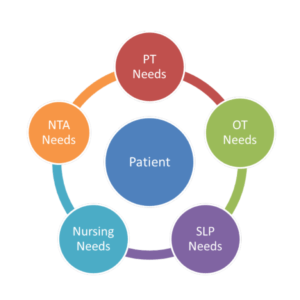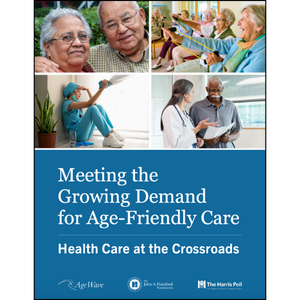Enhancing Medicare PPS Service Quality and Reimbursement
|
| Now is an increasingly challenging time for post-acute care providers. The Institute of Medicine has called for new systems of care to address the expanding needs of the elderly. Today’s skilled nursing facilities must adopt new systems that enable delivery and demonstration of high quality care and simultaneously achieve optimal financial performance. The challenge for long-term care providers is to meet the increased expectations of residents, families, referring physicians, hospitals, and payers within a climate of declining reimbursement and increased liability risk. Responding to that challenge requires a careful definition of the issues and use of a methodical system geared toward enhanced staff teamwork. Such a system is now being tested, with promising early results. Defining the Issues Care in the subacute setting is further hampered by the absence at the bedside of the most experienced nurses, who are pulled away from direct care to complete regulatory and administrative tasks and are generally overwhelmed by paperwork. The resulting model of care delivery in many nursing homes is inconsistent, fragmented, and lacks a team approach. Furthermore, the model has been focused for years on functional rehabilitation (to maximize reimbursement) and often does not appropriately address management of complex diseases or other medical needs. Ironically, inadequate stabilization of complex medical conditions frequently ensures that the elderly resident will not achieve optimal functional rehabilitation. Much of the nursing home industry has not yet learned to successfully manage the medically complex resident in an environment of limited resources and continues to operate based on blueprints of the past, when a nursing home’s function was to provide a safe environment for elderly individuals with functional limitations to live out the remainder of their lives with appropriate support. Government reimbursement systems were designed to reward services delivered to maintain functional and daily activity needs, and nursing home care systems adapted accordingly. This approach has produced caregivers and operational systems that are unprepared to address the needs of residents with complex acute and/or chronic medical conditions. Forging a New System |
|
| The system should also facilitate collaboration and information flow among disciplines and standardize and integrate the activities of the clinical team, tying together all the components of disease management. The first component of the system should facilitate a comprehensive, holistic, interdisciplinary admission assessment of the resident. To appropriately care for the increased medical needs of elderly residents, the nursing home of today must determine true primary and secondary acute and chronic diseases, baseline medical data (including vitals, I&O, pain, behavior, skin, medications, labs, and IV treatments), bowel and bladder behavior, diet and nutrition behavior, functional capacity, resident and family educational needs, psychosocial needs, and care coordination (especially discharge potential and planning). To accurately and efficiently assess a resident in all these components takes real collaboration of all disciplines working as a team. Furthermore, to achieve efficiency, the team must eliminate duplicative steps in the admission process (e.g., asking the resident his/her name and age five different times). Based on the admission assessment, the system should enable the care team to determine the relative clinical acuity of each of the resident’s medical conditions and direct the frontline clinical care process accordingly. The system should identify the most critical signs and symptoms (e.g., weight gain in congestive failure) for each disease and remind frontline caregivers to document, and supervising nurses to monitor, progress in disease management.
After compiling the primary and secondary chronic diseases and any high-risk conditions, the system should use that information to drive frontline care delivery. The system should provide a standard nursing assessment and nurse aide report that can be easily monitored from shift to shift and day to day. The system should monitor the frontline observations and assessments based on disease-specific triggers. This process should result in alerts and reports being sent to the appropriate disciplines so that they can stay on top of and manage the care delivery process. In the course of daily care delivery, a new acute episodic symptom (such as abdominal pain, fever, or shortness of breath) may occur that needs to be addressed appropriately. An effective outcomes system should immediately present the caregiver with an episodic protocol that addresses appropriate assessment or observations and then immediately alerts the key individuals on the team (DON, supervisor, physician), presenting them with vital statistics and medical history, including primary and secondary diseases. Once the admission and daily care delivery process is standardized and the information is collected in a central repository, the facility is in a position to continuously evaluate and improve its clinical processes. The care delivery process can be analyzed by disease to determine where changes in the process are needed and/or where the staff will benefit from additional education. Early Experience For each facility, the introduction of STA Healthcare’s Clinical Outcomes Management Solution (COMSÖ) System-including formal training, disease-specific education, and on-site coaching of caregiving staff by STA nurses-was carried out during the first three months of the implementation process. Implementation and oversight of the entire process within each home was led by an administrative committee of senior leaders (administrator, DON, assistant DON, and quality assurance nurse). A Performance Improvement Committee of frontline and supervisory nursing staff is responsible for monthly review and process improvement based upon the monthly Report of Outcomes and Quality Indicators for each home. Data collection was begun in month four at each home and then analyzed and reviewed independently by the chief medical officer of STA Healthcare. The Performance Improvement Process has been in place for 12 months at Facility A, ten months at Facility B, and three months at Facility C. Nine key performance indicators summarize the improvement experienced in each home (Table 1). Pre-implementation performance indicators serve as a baseline and are compared with the most recent quarterly data for each home-Quarter 2 (April, May, and June) of 2004. Skilled Bed Day Occupancy increased for all three homes by 25 to 108%. This increase was related to three factors: (1) more effective disease management of medical conditions for all residents, (2) resulting decline in rate of unnecessary readmission to the hospital, and (3) increasing resident referrals to the homes. Standardized, disease-specific nursing processes produced better assessments and more complete and accurate documentation, resulting in more effective communication with physicians. As a result, medical conditions were more effectively and more rapidly stabilized, thus enabling therapists to plan, achieve, and justify more aggressive functional targets. The result was an increase in average length of stay for all residents of 5.3 to 13.2 days. The application of standardized disease-management processes to all residents resulted in the discharge of increased numbers of skilled nursing residents to more independent settings (home, assisted living, and long-term care) in two of the three homes. Improved disease-specific management also directly reduced rates of return to the hospital. Payers (Medicare, HMOs) and hospital providers prefer to avoid return hospital admissions for the same condition within 30 days of the original discharge. All three homes decreased returns to the hospital, both within 30 days and for the same condition (Table 1). For each hospital readmission avoided, that resident had an extended skilled nursing length of stay of 8 to 10 days. As clinical outcomes improved, the homes began to use their performance data to market their services more aggressively to hospital discharge planners, HMOs, families, and physicians. Two of the three homes have already experienced sustained increases in referrals. Finally, as quality and outcomes of care improve, reimbursement also increases. Coincident with the above performance improvements, all three homes showed dramatic and sustained increases in average Medicare reimbursement per resident and total Medicare reimbursement per month (Table 1). Also, the more thorough daily assessment of residents, together with more accurate and more complete documentation, enhanced RUGs scores and increased the facility Case Mix Index. This produced an associated (although not calculated for this report) positive enhancement of reimbursement for Medicaid residents. While continuing performance improvement is the goal of each home, extrapolation of the current data from each home for Quarter 2 of 2004 on an annualized basis (Table 2), demonstrates the continuing impact of a standardized, disease-management approach to management of clinical and financial outcomes. James J. Riemenschneider, LNHA, MBA, is President and COO of STA Healthcare, Inc., 2132 Case Parkway North, Suite F, Twinsburg, Ohio 44087. L. Prentice Thompson is COO of Legacy Health Services. Additional information about the COMSÖ System is available by contacting Riemenschneider at JR@STAHealthcare.com. To comment on this article, please send e-mail to riemenschneider1004@nursinghomesmagazine.com. For reprints in quantities of 100 or more, call (866) 377-6454. |
I Advance Senior Care is the industry-leading source for practical, in-depth, business-building, and resident care information for owners, executives, administrators, and directors of nursing at assisted living communities, skilled nursing facilities, post-acute facilities, and continuing care retirement communities. The I Advance Senior Care editorial team and industry experts provide market analysis, strategic direction, policy commentary, clinical best-practices, business management, and technology breakthroughs.
I Advance Senior Care is part of the Institute for the Advancement of Senior Care and published by Plain-English Health Care.
Related Articles
Topics: Articles , Medicare/Medicaid











